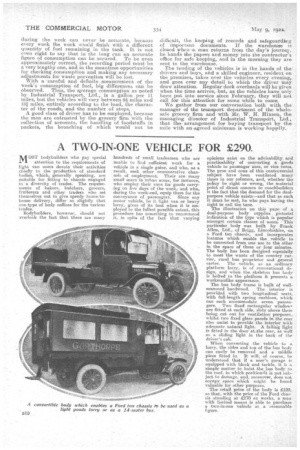A TWO-IN-ONE VEHICLE FOR E290.
Page 12

If you've noticed an error in this article please click here to report it so we can fix it.
MOST bodybuilders who pay special attention to the requirements of light van users devote their activities chiefly to the production of standard bodies, which, generally speaking, are suitable for fitting to chassis engaged in a diversity of trades. The requnements of bakers, butchers, grocers, fruiterers and other traders who set themselves out to give speedy house-tohouse delivery, differ so slightly that one type of body suffices for the various trades.
Bodybuilders, however, should not aver1cFok the fact that there are many
hundreds of small tradesmen who are unable to find sufficient work for a vehicle in a single guise, and who, as a result, seek other remunerative channels of employment. Their are many small users in urban areas, for instance, who employ their vans for goods carrybig on five days of the week, and who, during the week-end, equip them for the conveyance of passengers. Since any motor vehicle, be it light van or heavy lorry, gives of its best when it is employed to the fullest possible extent, this procedure has something to recommend it, in spite of the fact that varying
opinions exist on the advisability and practicability of converting a goods vehicle to passenger uses, or vice versa. The pros and cons of this controversial subject have been ventilated many times in our columns, and, whether the policy be right or wrong, the material point of direct concern to coachbuilders is the fact that the demand for the dualpurpose vehicle exists—and that as such it must be met, he who pays having the right to call the tune.
The illustration on this page of a dual-purpose body supplies pictorial indication of the type which is popular amongst certain classes of users. This particular body was built by -Frank Allen, Ltd., of Brigg, Lincolnshire, on a Ford ton chassis, and incorporates features which enable the, vehicle to be converted from one use to the other in the space of three or four minutes. The body has been designed especially to meet the wants of the country carrier, rural bus proprietor and general carter. The vehicle, as an ordinary platform lorry, is of conventional design, and when the skeleton bus body is bolted to the platform it presents a workmanlike appearance.
The bus body frame is built of well
seasoned hardwood. The interior is provided with two longitudinal seats, with full-length spring cushions, which can each accommodate seven passengers. Two fixed rectangular window are fitted at each side, slotsabove them being cut out for ventilation purposes. whilst two fixed glass panels in the rear also assist to provide the interior with adequate natural light. A falling light is fitted in the door at-the rear, as well as a sliding light in the back of the driver's cab.
When converting the vehicle to a lorry, the sides and top of the bus body can easily be removed and a middle piece fitted in. It will, of course, he understood that if a user's garage is equipped with block and tackle, it is a simple matter to hoist the bus body to the roof, in which position;it is not subject to damage, and, moreover, does not occupy space which might be found valuable for other purposes. The retail price of the body is £120, so that, with the price of the Ford chassis standing at £170 ex works, a man with limited means is able to purchase a two-in-one vehicle at a reasonable figure.




































